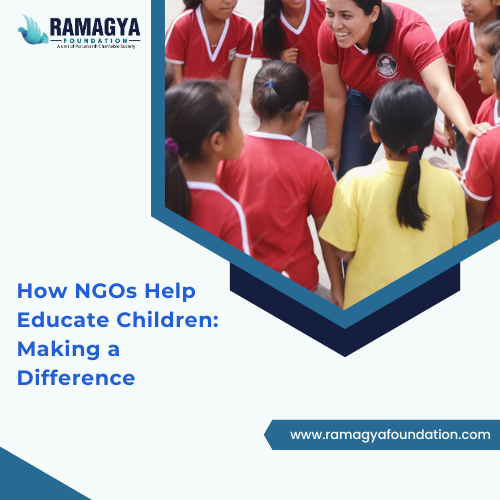Education isn’t just about understanding facts and figures, it’s about building individuals’ confidence and encouraging critical thinking and laying the foundations for a better future. In reality, many children around the globe are unable to access education because of insufficient resources, poverty or societal expectations.
This is the point at which Non-Governmental Organizations (NGOs) step in, playing a crucial role in closing these gaps and ensuring that every child is able to access a high-quality education.
We’ll look at five ways that the education NGO in India can help educate children, focusing upon Ramagya Foundation an NGO for Education and their transformative programs:
- Access to Education
The right to education is a basic right, but millions of kids around the world are not in school due to a variety of causes. Education NGO in India are working hard to ensure all children have access to education opportunities. They set up schools in remote locations, provide transport for children living in areas far from schools and design flexible programs for learning to meet the diverse needs of children.
The Impact of the Ramagya Foundation: Ramagya Foundation’s Umeed program is geared towards offering elementary education to children who are not in school. Through the development of learning skills and self-confidence, Umeed assists children in preparing them to be accepted into mainstream schools. Umeed targets children who are not privileged who are disadvantaged, teaches them skills and assists dropouts in getting back into school.
- Scholarships and Sponsorships
The financial burdens of life often hinder children from going to school or finishing their education. Non-profit organizations address this issue by providing scholarships and sponsorships that pay for tuition costs and books, uniforms and other necessary supplies. These programs ensure that every child, no matter what their circumstances, can achieve their education goals.
The Impact of the Ramagya Foundation: Ramagya Foundation’s Unnati program helps students who are in college and school enrollment by providing scholarships and high-quality education guidance. Through empowering children with financial aid and education support, Unnati opens doors to a brighter future.
- Infrastructure Development
The school infrastructure plays an essential aspect in creating a positive learning environment. NGO’s with a presence in India invest in the building and renovation of libraries, schools, classrooms as well as sanitation and hygiene facilities. They make sure the children are provided access to secure and comfortable environments where they can grow and learn.
The Impact of the Ramagya Foundation: Ramagya Foundation’s Sanganak program is focused on the development of computer literacy and advancing the knowledge of children in technology. Through the teaching of the engineering of computers like repairs and installation, Sanganak equips children with fundamental technical skills and prepares them for opportunities in the age of digital.
- Teacher Training and Assistance
Teachers are the core of education. NGO’s in India offer training and professional education opportunities to teachers, empowering teachers with effective teaching techniques and techniques. Highly trained teachers not only improve learning outcomes, but also motivate and inspire students to achieve their goals.
The impact of the Ramagya Foundation: Ramagya Foundation’s after school Special Program offers multidisciplinary educational and artistic activities. Through nurturing children’s talents as well as abilities, the program allows children to discover their creative potential and enhance their skills outside of the traditional classroom environment.
- Advocacy and Engagement with the Community
Non-governmental organizations in India collaborate with local communities to educate the community about how important education is. They collaborate with local officials as well as parents and other people in the community to push for policies that protect children’s rights to an education. Participation from the community ensures that educational programs are based on a sensitive understanding of culture and long-term sustainability.
The impact of the Ramagya Foundation: Ramagya Foundation’s Satrang program promotes creativity among youngsters aged between 6 and 16 years old. Through bridging the gap between the opportunities to learn through creativity, Satrang empowers children through professional guidance, encouraging their talents as artists and personal development.
Conclusion
They play a crucial role in improving the lives of children by providing education. In terms of offering access to education and scholarships, or enhancing infrastructure, training teachers or engaging communities, Education NGO in India such as Ramagya Foundation are making a huge impact.
Together we can continue to help these programs and ensure that each child is provided with an education that they are entitled to, opening the way for a brighter and more equal future.
Education isn’t just an instrument to improve your personal life but it can also be an instrument to bring about positive changes in society. Let’s continue to encourage and recognize the work of NGOs in India to educate and support children around the world.
